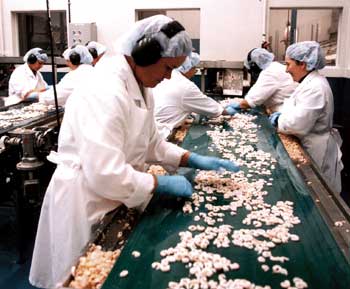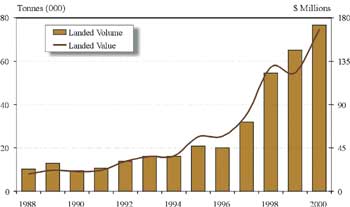Fisheries Diversification
Significant industry change has occurred since the 1992 cod moratorium. Prior to the moratorium, shellfish accounted for less than 10% of total fish landings in the Province and less than 30% of total landed value. In 2000, shellfish dominated the industry, accounting for almost 60% of total landings and more than 75% of landed value.
By volume, shrimp is the largest species in the shellfish sector (followed closely by crab). Between 1991 and 2000, the landed volume grew from 10,600 tonnes to 76,600 tonnes, and landed value grew from $21.7 million to $168 million.
Development of the Shrimp Fishery
Prior to 1997, the northern shrimp fishery was offshore-based. Offshore landings (i.e., landings harvested by license holders from the Province) increased from less than 5,000 tonnes in the late 1970s to about 16,000 tonnes by 1996, and to almost 27,000 tonnes in 2000.
Since 1997, the inshore shrimp fishery has undergone significant expansion and diversification. Total inshore landings in the northern and Gulf areas increased from about 4,000 tonnes in 1996 to over 49,600 tonnes in 2000.
|
| |
 |
|
|
| Total Shrimp Landings and Landed Value |
 |
 |
|
| |
| Source: Department of Fisheries and Aquaculture |
| |
Efforts to ensure product quality have accompanied growth in the inshore shrimp fishery. Harvesters use trip limits (i.e., maximum catch per trip) to maintain quality, and adhere to multi-year management plans as a means to ensure long-term sustainability of the shrimp fishery. In both the offshore and inshore fishery, bycatch (i.e., fish not intended to be harvested) is limited through the use of innovative and locally developed net technologies such as the Nordmore Grate.
Prices paid by processors to harvestors are set using a Final Offer Selection (FOS) price setting model. The FOS model was enacted in legislation in 2000 and is subject to industry review in two years. It has ensured a timely start and orderly conduct of the fishery every year since its inception in 1998.
Eleven plants, employing over 1,200 workers, are licensed to process shrimp, and a twelfth facility is under construction. Inshore shrimp are cooked and peeled, and are marketed in the United States and Europe. European tariffs on Canadian product, which negatively affect the ability of local processors to compete in that market, remain an outstanding issue. While a 4,000 tonne allowance is in place, talks are ongoing in an effort to further reduce trade impediments of this nature.
|
| |
Photo: Department of Fisheries and Aquaculture
Shrimp processing |
|

